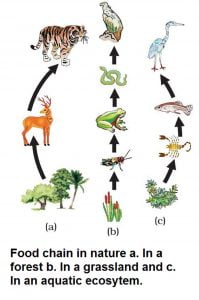Our Environment Short Questions Class 10 Science
1. Examples of an ecosystem are:
a. A pond.
b. A garden.
c. An aquarium.
c. A forest.
d. Delhi.
Answer: All options are correct except d.
An ecosystem comprises of an area where organism (biotic component) interact with their physical environment. It can be natural or human-made. A forest is a natural ecosystem, whereas a pond or an aquarium are examples of a human-made ecosystem. Cities like Delhi or any other geographical region comprise multiple ecosystems and forms a biome. So options a, b, and c are correct. A mountainous or hilly area, a coastal plain etc. have peculiar climate, temperature and rainfall. They form separate biomes.
2. A series of organisms on the basis of feeding habit is a _____.
Answer: Food chain.
Answer: Producer.
4. What is a food web?
Answer: In an ecosystem, an organism feeds on different organisms. It forms a complex food chain. So we use the term Food web instead of a food chain.
5. What is the biological magnification?
Each organism requires a regular amount of food throughout his lifetime. For this, it eats a large amount of organism of the lower trophic level. As a result, harmful chemicals like DDT, arsenic, and mercury etc accumulate at each trophic level. This results in higher concentration at higher trophic levels. We call this phenomenon as Biological magnification.
6. How harmful chemical enter a food chain?
We use different chemicals and pesticides in agriculture forms to protect crops from diseases. These chemicals are nonbiodegradable. Crops absorb these chemicals in their body and enter our food chain. Remaining chemicals are washed away by water and are absorbed by aquatic plants and animals. When we eat these plants and animals, chemical enter in our body.
7. What are decomposers?
Microorganisms like bacteria and fungi thrive on the dead plant parts and animal. They degrade them into simple inorganic materials. We call them decomposers.
8. How much amount of sunlight is converted into food by plants?
Plants convert 1% of the incident light on their leaves and convert them into food.
9. What id 10 per cent law?
In a food chain, each organism eats the organism below its trophic level to meet its energy requirement. During this process, much of energy is wasted as heat to the environment and other processes like digestion. On average only 10 per cent of this energy is available for the next trophic level. We call this a 10 per cent law.
10. How ozone protects us from UV radiation?
Ozone (O3) absorbs the wavelength of shorter length (UV rays) and forms rays of longer wavelength.
See also: Activity solution: Chapter 15, Our Environment.
